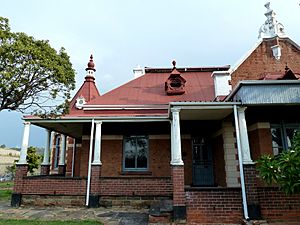S. P. E. Trichard facts for kids
Quick facts for kids
S.P.E. Trichard
|
|
|---|---|

Kommandant (Afrikaans for Commander) SPE Trichard, Commissioner for natives' affairs of Middelburg, Transvaal
|
|
| Born | 23 January 1847 Ohrigstad
|
| Died | October 1907 (aged 60) Kenya
|
| Occupation | Boer soldier |

Stephanus Petrus Erasmus Trichard (born January 23, 1847, in Ohrigstad – died October 1907, in Kenya) was an important soldier. He was a commander for the South African Republic (also known as ZAR). He fought in both the First Boer War and the Second Boer War.
Trichard took part in many battles. He helped fight against different groups of African people near the South African Republic. During the First Boer War (1880–1881), he was part of the attack on Majuba Hill. Later, he helped stop the Jameson Raid (1895–1896).
After his time as a soldier, he led the State Artillery. He was also a commander in the Second Boer War (1899–1902). After the war, he moved with a group of Boer families to East Africa. He passed away there in 1907.
Contents
Early Life and Military Service
Stephanus Trichard was the son of Carolus Johannes Tregardt. Carolus was a "Voortrekker," which means he was one of the early Dutch-speaking settlers who moved inland in South Africa. Stephanus's grandfather, Louis Tregardt, was also a famous Voortrekker.
As a young man, Stephanus Trichard joined the ZAR's military actions. He fought in campaigns against groups like the Mapoch people and Sekhukhune. In 1880, he was chosen as a "field cornet" for the Middelburg area. A field cornet was a local military leader.
Soon after, he fought in the Battle of Bronkhorstspruit and the Battle of Majuba Hill. He became the commander for Middelburg. He also led military trips against the Rain Queen Modjadji in 1890, Malaboch in 1894, and Chief Makgoba in 1894–1895.
Leading the Transvaal State Artillery
Trichard and his Middelburg Commando played a big part in stopping the Jameson Raid. This was an attack by Leander Starr Jameson and his group in late 1895. Because of his actions, Trichard was promoted in 1897. He became the commander of the ZAR's State Artillery Regiment.
The State Artillery was a special group of soldiers who used cannons. Trichard helped make this group even stronger and more modern. In 1897, the State Artillery went on an expedition to Swaziland. In 1898, they were involved in the ZAR-Venda War against Makhado.
Role in the Second Boer War
Before the Second Boer War began, Lieutenant-Colonel Trichard had some different ideas. He did not think building forts around Pretoria was a good plan. He also thought the ZAR should be more friendly towards the United Kingdom.
During the war, he fought on the Natal front. He was involved in battles at Dundee and Ladysmith. He then moved back with the Boer forces to the Orange Free State. He fought in the Battle of Brandfort and later the Battle of Donkerhoek in the ZAR.
At the Battle of Dalmanutha in August 1900, Trichard showed how powerful the State Artillery was. However, this battle also marked the end for his unit. As the war changed to a guerrilla war (small, surprise attacks), cannons were no longer as useful. The cannons had to be destroyed. Trichard's unit was split up. Even though his main job was no longer needed, he kept his rank. He led a part of the Middelburg commando until the war ended in 1902.
After the war, Trichard, who used to be a rich farmer, asked for money to cover his war damages. He was offered £300, but he refused it. He wrote down his experiences during the Second Boer War in a book of memories.
Searching for a New Home
After the war, Trichard's son, Charles, thought about moving to Madagascar. Charles's grandfather, Carolus, had explored Madagascar years before. The Trichards were part of a group called "bittereinders." These were people who fought to the very end of the war and were now looking for new places to live.
In 1904, Colonel Trichard joined a group that traveled to German East Africa (modern-day Tanzania). He insisted they also visit Madagascar. They met the Governor General there, who allowed them to explore. However, they decided not to settle in Madagascar. There were three main reasons: the strong influence of the Catholic Church, many cases of malaria, and strong Asian influences.
From Madagascar, they went to Dar es Salaam. They got permission to look at the area around Mount Meru. In 1905, Trichard and his son Charles moved to German East Africa. Trichard eventually settled in Nakuru in Kenya. He died there in October 1907 during a hunting trip.
Literature
See references.
- Breytenbach, J. H. (1969–1996). Die Geskiedenis van die Tweede Vryheidsoorlog in Suid-Afrika, 1899–1902. Pretoria: Die Staatsdrukker.
- Breytenbach, J. H. (1969). Die Boere-offensief, Okt. – Nov. 1899. Die Geskiedenis van die Tweede Vryheidsoorlog in Suid-Afrika, 1899–1902. I. Pretoria: Die Staatsdrukker. OCLC 798106662.
- Breytenbach, J. H. (1971). Die eerste Britse offensief, Nov. – Des. 1899. Die Geskiedenis van die Tweede Vryheidsoorlog in Suid-Afrika, 1899–1902. II. Pretoria: Die Staatsdrukker. https://books.google.com/books?id=31L9XwAACAAJ.

